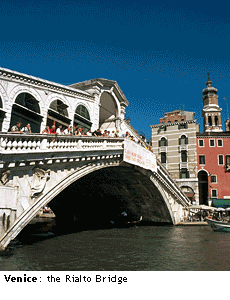Buildings and monuments
The historical buildings and most important monuments in Venice, from Palazzo Ducale to the Rialto Bridge...
Santa Croce
- Fondaco dei Turchi
This building was originally built at the beginning of the 13th century by Giacomo Palmieri, the consul of Pesaro on the Atlantic coast, who fled to Venice where he founded one of the greatest noble families in the city: the Pesaro family. In 1621, the Pesaro family rented the palace to Ottoman merchants and from then on the palace was known as the Fondaco dei Turchi (the Turks’ Warehouse). Later, when trade with the East began to decline, the palace was abandoned by the Ottomans and fell into ruin. In 1880, the Venice City Council bought the Fondaco and renovated it , whilst maintaining the characteristics of the original buildings, i.e. its Venetian-Byzantine façade covered in marble. This building has been the home of the Natural History Museum in Venice since 1924.
- Ca’ Mocenigo
The Mocenigo family, from Lombardia, settled in Venice a long time ago and became one of the symbols of the city itself. One of the family branches lived at San Stae, where one of the most striking buildings in Venice was built: Ca’ Mocenigo, built with a main entrance known as a “portego” in the central block. The building now belongs to the City Council and can still be admired in all its glory with the original eighteenth century furnishings and decorations. Palazzo Mocenigo also houses the Vittorio Cini collection of curtains, hangings and religious fabrics.
San Polo
- The Rialto Bridge
The Rialto Bridge was originally the only permanent connection between the two banks of the Grand Canal. It is said that in 1172, a bridge made from barges was designed, which was then replaced with a bridge with wooden columns a few years later. This bridge was destroyed in 1310. In 1444, a new wooden bridge was built that was much bigger than the previous one and which even had shops on it.
The final stone version of the Rialto Bridge, as we know it today, was built in the period 1588-1591 by Antonio da Ponte. Building the bridge was difficult due to the instability of the site and its height (8 meters).
- The House of Carlo Goldoni
Carlo Goldoni, the famous Venetian playwright, was born in 1707 at Palazzo Centani, located alongside Ponte San Tomà. The building has a façade with a pointed arch that faces the canal and can be seen from the bridge. It has a wonderful courtyard and an open air staircase. A committee of citizens bought the house in 1914, following an idea by Aldo Ravà who was a famous fan of Venetian culture. A center for the preservation of the artists papers was then created there. The buildings has been the home of the Institute of Theatrical Studies (Istituto degli Studi Teatrali) since 1952. The theater section of the Correr Museum Library is also housed there.
Carlo Goldoni’s most famous plays, written and acted in dialect, are: I Rusteghi (1760), The Villeggiatura trilogy (1761) and Le Baruffe Chiozzotte (1762).
- Scuola Grande di San Rocco
The Scuola Grande di San Rocco is a majestic building made from white marble, designed by the architects Bon and Scarpagnino around 1400. It was declared a School in 1489 by the Concilio dei Dieci. The carvings on the façade are very intricate and recall the typical style of the Venetian sculptors from the mid-15th century. The school played a role of helping the poor and protecting the city’s artistic assets. When the Marine Republic fell from power, the School was left to rack and ruin and most of the holy decorations were stolen. The School was reopened for religious services in 1806, thanks to some donations from rich citizens. It once again took on its role to help the poor, in spite of the fact that it did not have many financial resources. Works by Tintoretto, Tiziano, Tiepolo and Giorgione, all illustrating the bible, can still be seen inside the school.
San Marco
- Palazzo Ducale
This exceptional building was the center of Venice’s political, social and economic life right from the beginning. Palazzo Ducale was the private residence of the Doge, but it was also the home of the Government’s and the Courts’ main offices . There is some proof that the original building dates back to the first half of the 9th century, a building that was then changed through several renovations that were carried out over the centuries. Substantial changes were made in 1173, during the rule of the Doge Sebastiano Ziani, and the palace was expanded. However, in 1340, the building took on a truly grandiose size when the Gothic style wing was built that faces the San Marco bay, where the Greater Council meeting were held. The portico supported by the large columns and the upper open gallery that face the bay are wonderful. The Gothic-style Porta della Carta, the entrance of honor to the palace, dates back to the 15th century. It was given this name as the proclamations issued by the Republic were attached to this door.
The rooms inside the palace are full of frescoes depicting the history of the Republic by Masters such as Tiepolo, Tiziano, Veronese, Bassano and Palma il Giovane, all kept in valuable golden wooden frames.
- The “Procuratie” and the Napoleonic wing
Piazza San Marco is bordered on the right and on the left sides by the Procuratie, which are connected by the Napoleonic Wing. There are now several shops under the porticoes, the famous Café Florian and Café Quadri and there are also some luxurious Venetian jewelers such as Nardi and Missaglia. Both the Procuratie, the Old and the New one have galleries over the 50 arches of the ground floor portico. The third side of the square, the one that face the Basilica, is taken up by the Napoleonic Wing. This is a building in Neo-classical style, built on the wishes of Napoleon in 1807. In order to build a ballroom, Napoleon ordered for the ancient Church of San Geminiano to be knocked down. The Napoleonic Wing now houses
the Correr Museum collection.
The Torre dell’Orologio (the Clock Tower) is also located on the side of the old Procuratie. There is also the archway that takes you to the Mercerie. The tower is topped by a terrace where there is a large bell and two bronze statues known as the “Mori”. The clock is underneath the statues. The clock face is gold and blue enamel and shows the time, the lunar phases and the zodiac signs.
- Scala Contarini known as “del Bovolo”
Near Campo San Bortolo, hidden among a labyrinth of alleyways, there is one of Benice’s most unusual sites: Scala Contarini, known as “del Bovolo”, which was built around the 17th century. This strange name was given to it due to its strange spiral shape that reminds one of a snail, which in Venetian dialect is Bovolo. The staircase winds up Palazzo Contarini façade and is seen as a high cylindrical tower from where you get a charming view of Venice’ rooftops.
Cannaregio
- Ca’ d’Oro
Palazzo Ca’ d’Oro, now home of the Franchetti Gallery, is one of the main attractions of Venetian Gothic architecture, built at the beginning of the 15th century on the wishes of Marini Contarini. The name of Ca’ d’Oro (The Golden home) comes from the wealth of gold leafing that once decorated its façade. The original project was probably by the architect Marci D’Amadio, but the work was carried out by Lombard craftsmen and then later by Venetian ones. Ca’ d’Oro changed owner several times and was finally bought and renovated by the Baron Giorgio Franchetti in the 19th century. He then donated his own collection of paintings and this building to the State in 1916. In 1927, the palace was turned into a museum that now houses several works of art by Tiziano and Tintoretto and some Gothic and Renaissance furniture.
Dorsoduro
- Ca’ Rezzonico
Ca’ Rezzonico is a large building that looks down onto the Grand Canal and which is now home to the Eighteenth Century Museum in Venice. The original design of the building was commissioned by the Priuli-Bon family and was carried out by Baldassare Longhena during the first half of the 17th century. Around 1745, another floor was added to the building, just as the Rezzonico family, the new owners of the building, wished. Some classical elements have been used on the façade, as they were much in fashion at the time. They match the rooms and the interior decorating. The large staircase can be reached from the entrance hall on the ground floor: this is one of the most magnificent entrances in the entire city. Ca’ Rezzonico was bought by the English poet Robert Browning and then by the Baron Hirschel de Minerby, the last private owner. The building was then acquired by the City Council (1925) and was turned into a museum.
Go to directories of the Web Sites
Go to the itinerary:
|


